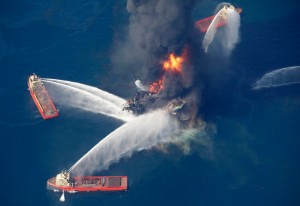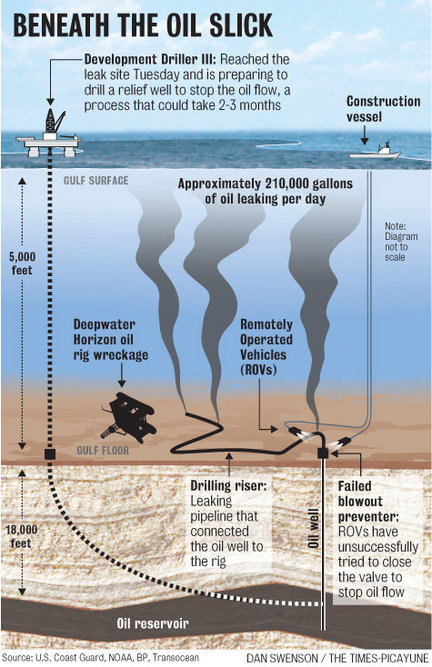Earth Day 2010 ironically kicked off with a blazing bonfire at the Deepwater Horizon drilling rig, 66km off the Louisiana coastline. The rig was contracted to a BP plc unit (who faces the brunt of bad PR), but it was owned and operated by Transocean Ltd, the world’s biggest offshore drilling contractor. After the initial explosion the platform burned for two days, then it sank into the Gulf of Mexico. WattsUpWithThat explains the drilling technology and below is a graphic from the Times-Picayune showing how difficult it is to shut off the leak. Images, like the one above, can be found on the boston.com site.
Full-scale investigations are under way to determine the cause of this accident, with all parties using the event to advance their political agendas, particularly with the climate policy negotiations currently raging on the Hill. Notwithstanding repercussions across the entire US ecology and economy, a quick note about the industry and technology:
There are over three thousand oil rigs in the Gulf extracting and moving crude petroleum to production. There has not been (that I’m aware of!) a blowout/spill in 30 years (since Ixtoc I in 1979). These platforms are amazing marvels of technology. Have you seen the National Geographic Megastructures on oil rigs? Their extreme technologies are alternately alarming and awe-inspiring with their attendant high risks and lessons which can only be learned the hard way. That said, accidents are bound to occur. Their use extends beyond extractive industries, and holds a lot of promise for geologic research.
Economically: Louisiana’s only natural defense against Gulf hurricanes (like 2005’s Katrina) is the vast marshlands of the Mississippi Delta. But given the engineering modifications of the Mississippi River and mismanaged agricultural technologies, this rapidly eroding coastal ecosystem today boasts the world’s largest and most notorious dead zone (the geographically larger Baltic Sea area having been a dead zone for millenia, but reversing since the dissolution of the Soviet Union and the collapse of demand on expensive fertilisers, among many things). Rapid coastal erosion removes this buffer zone and exposes to the storm surges 1) the city of New Orleans, 2) the state’s vital oil and gas infrastructure, and 3) its energy distribution infrastructure upon which the entire country relies upon. It is the natural nursery ground for 40% of the country’s seafood. It is the natural habitat for over five million waterfowl and migratory birds, which is a significant tourism draw throughout the year. This watershed disaster will be calamitous for an already besieged economy.
Cleanup: Satellite data analysis boosts the initial crude oil leak estimates up (from an initially announced 1000, then 5000 just days ago) to a *whopping* 25,000 barrels a day, putting us less than two weeks away from eclipsing the Exxon Valdez catastrophe which drained 270,000 barrels into Alaska’s Prince William Sound in 1989. The Sound was a challenge to clean up. How do you correct an environmental disaster of this magnitude in impenetrable swamps?
oh New Orleans… screwed. time and again.


PaleoCuisine|Caveman Diet|Paleo Meals…
[…]abejero[…]…